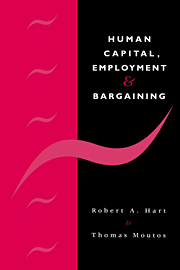Book contents
- Frontmatter
- Contents
- Preface
- 1 Overview
- 2 Labour demand and efficient contract models
- 3 Turnover costs, firm-specific training and unemployment
- 4 Employment and bargaining
- 5 Choice of compensation, unemployment insurance and policy issues
- 6 Team-related human capital and bargaining
- 7 Coalitional versus neoclassical firms
- 8 Future developments
- Bibliography
- Index
2 - Labour demand and efficient contract models
Published online by Cambridge University Press: 05 November 2011
- Frontmatter
- Contents
- Preface
- 1 Overview
- 2 Labour demand and efficient contract models
- 3 Turnover costs, firm-specific training and unemployment
- 4 Employment and bargaining
- 5 Choice of compensation, unemployment insurance and policy issues
- 6 Team-related human capital and bargaining
- 7 Coalitional versus neoclassical firms
- 8 Future developments
- Bibliography
- Index
Summary
Human capital investment and the marginal worker
What determines the firm's hiring decision with respect to the marginal worker? In the basic static perfectly competitive neoclassical theory of labour demand, with an assumed fixed stock of capital, the derived demand curve gives the answer that employment takes place at the point where the value of labour's marginal product is equated to its marginal cost. In a simplified setting, abstracting from all other forms of labour costs, this latter price is usually taken to be the wage rate. Taken alone, the relative usefulness of this result is predicated on the labour supply conditions facing the firm. It becomes most effective at describing the wage–employment effects of supply shocks as we approach the polar case of either an infinitely elastic or a completely inelastic supply curve. Of course, many other factors bear on this relationship and here we wish to focus on one of them, the role of employee training.
Early developments of human capital theory in a firm-level context concentrate attention on a marginal worker (Becker, 1962 and 1964; Oi, 1962). Decisions over both employment and wages are influenced by expenditures on hiring and training. Training is divided into two categories, general and specific. Knowledge and skills gained through general training enhance the worker's marginal product in the own-firm and in competing firms. Firm-specific training, by contrast, has no value outside the firm and therefore implies no impact on the opportunity wage.
- Type
- Chapter
- Information
- Human Capital, Employment and Bargaining , pp. 12 - 47Publisher: Cambridge University PressPrint publication year: 1995



